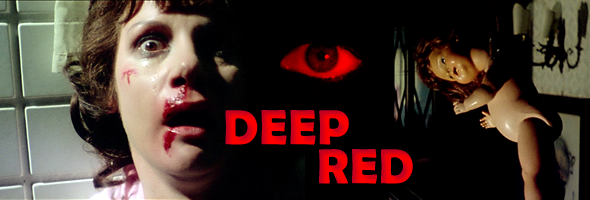
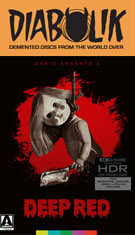

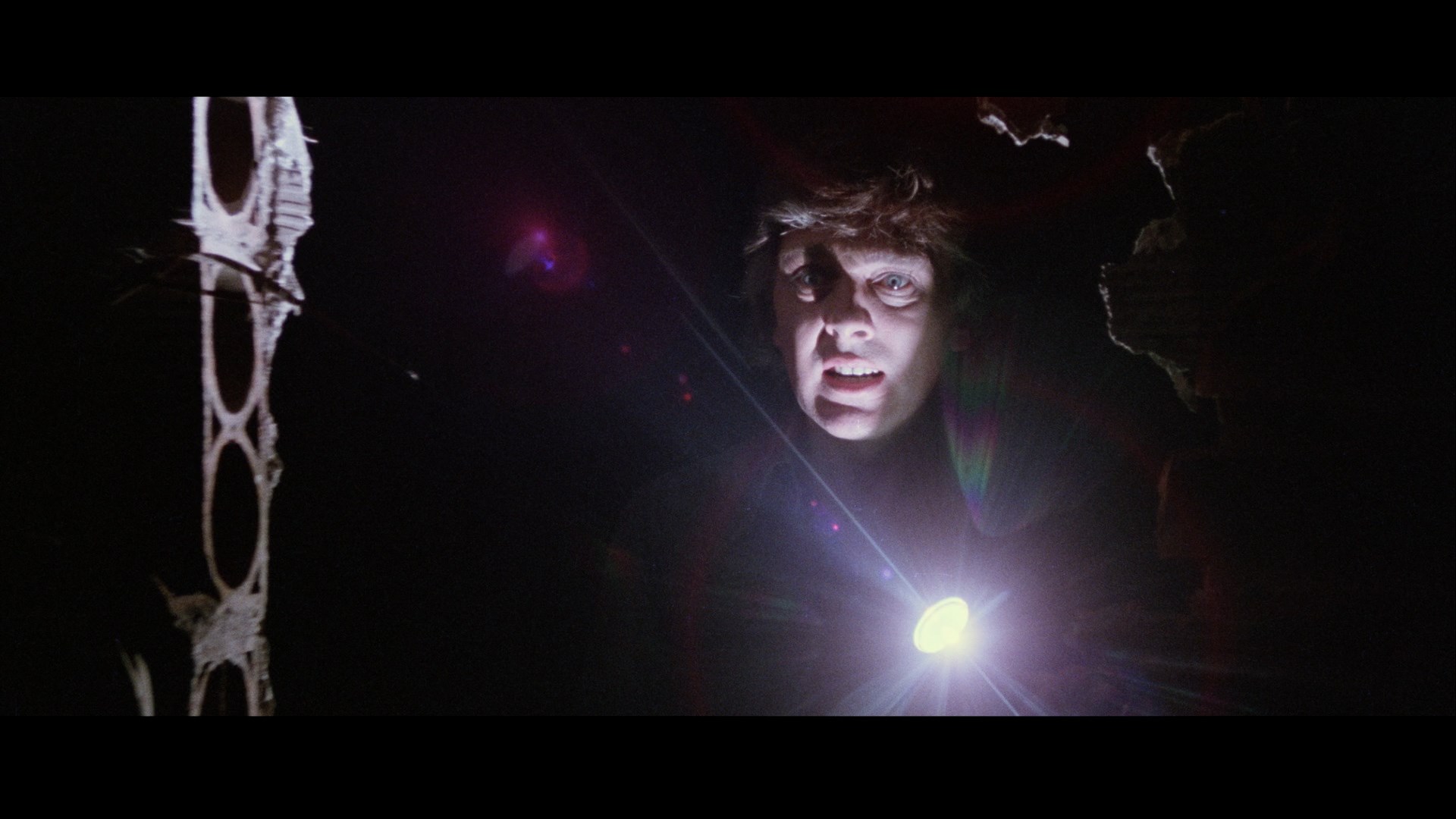 while revolutionizing what the
while revolutionizing what the 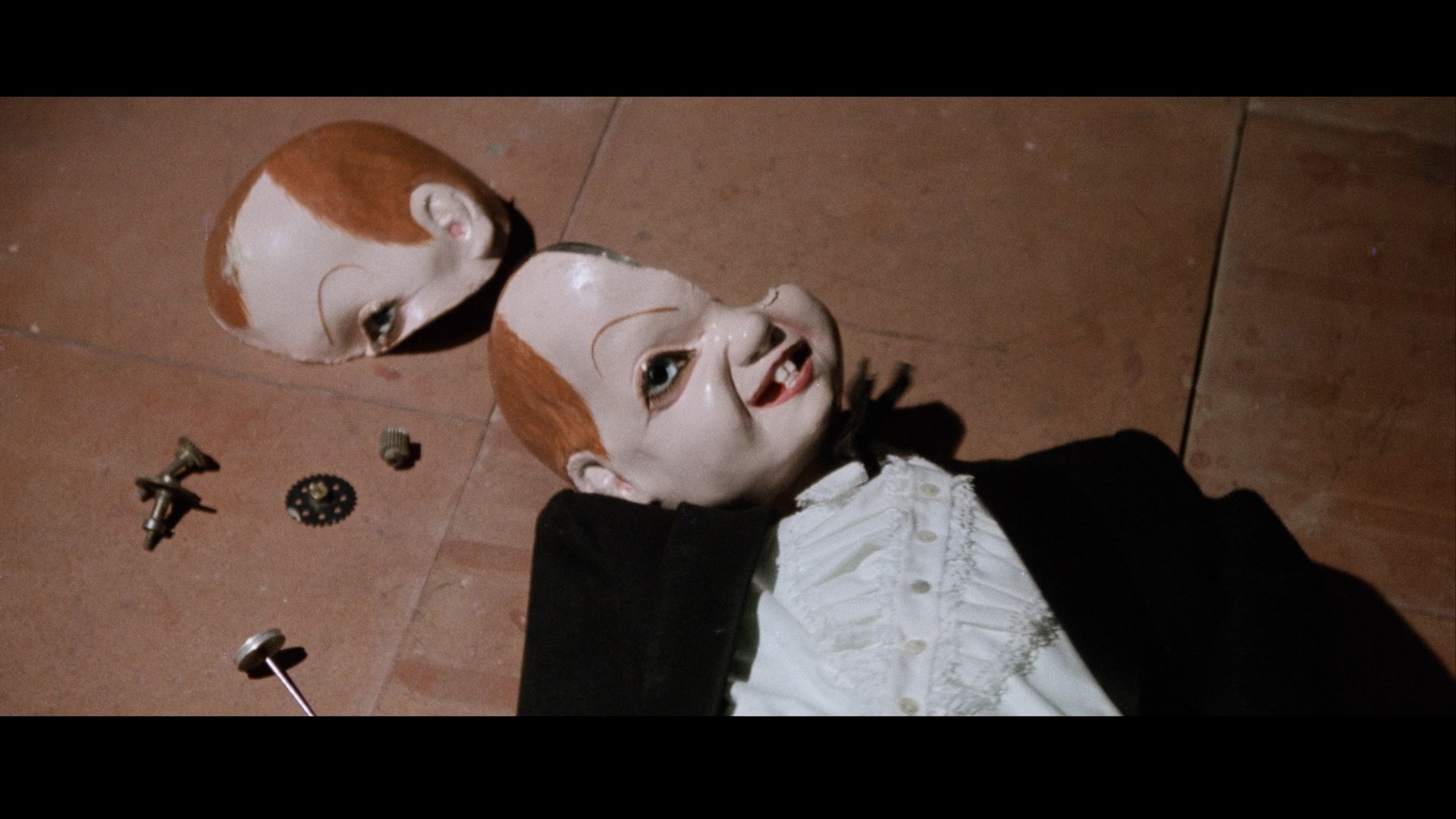 world now knows as the giallo. Apart from Mario Bava, no one had managed to create such an ingenious combination of visual style, devilish plotting, and a gripping soundtrack; indeed, this is not only perhaps Argento's greatest film, but one of the highlights of Italian cinema as a whole. Deep Red is one of those few, fortunate creations in which every element seems to fall perfectly into place. Argento at the height of his powers is enough of an asset, but the film also has engaging, first-rate performances from Hemmings and Nicolodi, a groundbreaking and often imitated rock score by Goblin with some more traditional contributions by Giorgio Gaslini (buy the soundtrack!), brilliant mobile camera work by Luigi Kuveiller, and enough shocks to keep the most jaded horror fan on the edge of his seat. Many of the film's gory set pieces have been copied over the years, with John Carpenter starting the trend with Halloween (the sofa/knitting needle scene) and Halloween II (the scalding bathtub murder). Its influence has been felt for decades now, even leading to a bizarre 2008 stage musical by Goblin member Claudio Simonetti and constant rumors of a remake (sometimes in 3-D), at one time even attached to George Romero.
world now knows as the giallo. Apart from Mario Bava, no one had managed to create such an ingenious combination of visual style, devilish plotting, and a gripping soundtrack; indeed, this is not only perhaps Argento's greatest film, but one of the highlights of Italian cinema as a whole. Deep Red is one of those few, fortunate creations in which every element seems to fall perfectly into place. Argento at the height of his powers is enough of an asset, but the film also has engaging, first-rate performances from Hemmings and Nicolodi, a groundbreaking and often imitated rock score by Goblin with some more traditional contributions by Giorgio Gaslini (buy the soundtrack!), brilliant mobile camera work by Luigi Kuveiller, and enough shocks to keep the most jaded horror fan on the edge of his seat. Many of the film's gory set pieces have been copied over the years, with John Carpenter starting the trend with Halloween (the sofa/knitting needle scene) and Halloween II (the scalding bathtub murder). Its influence has been felt for decades now, even leading to a bizarre 2008 stage musical by Goblin member Claudio Simonetti and constant rumors of a remake (sometimes in 3-D), at one time even attached to George Romero.  and you will kill again," she proclaims, pointing out into the audience. Soon after, she is brutally killed in her apartment, an act witnessed
and you will kill again," she proclaims, pointing out into the audience. Soon after, she is brutally killed in her apartment, an act witnessed  from afar by a British pianist, Marcus Daly (Blow Up's Hemmings). Spunky reporter Gianna Brezzi (Nicolodi) realizes Marc's value as an eyewitness but cannot protect him as the killer continues cutting a bloody path right to Marc's door. Through some amateur detective work, our neurotic hero deduces the killings may be related to an abandoned, supposedly haunted old house on the outskirts of town.
from afar by a British pianist, Marcus Daly (Blow Up's Hemmings). Spunky reporter Gianna Brezzi (Nicolodi) realizes Marc's value as an eyewitness but cannot protect him as the killer continues cutting a bloody path right to Marc's door. Through some amateur detective work, our neurotic hero deduces the killings may be related to an abandoned, supposedly haunted old house on the outskirts of town.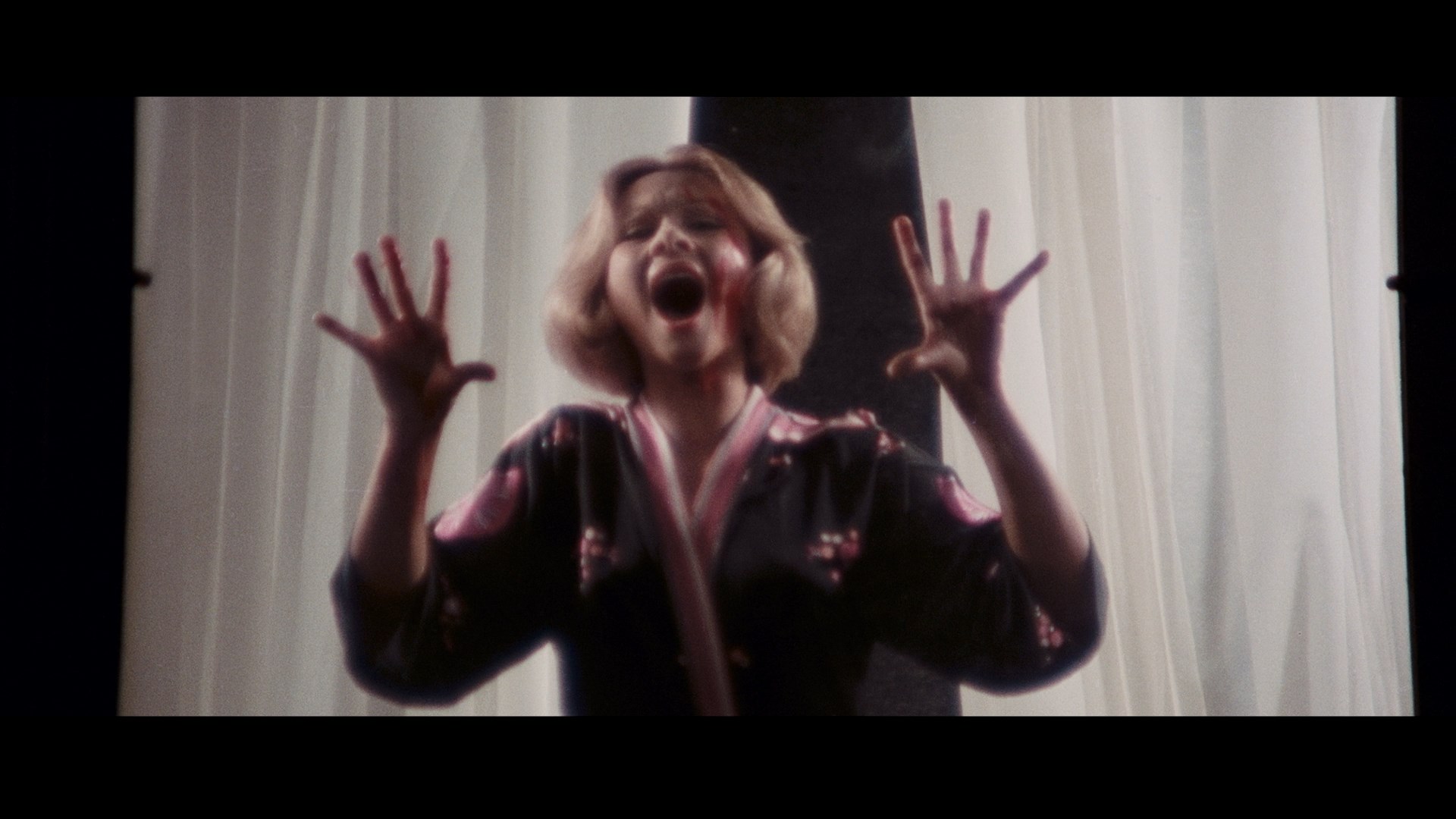 on in the film is also much easier to see, as is the revelation concerning that creepy fresco. While the film's
on in the film is also much easier to see, as is the revelation concerning that creepy fresco. While the film's 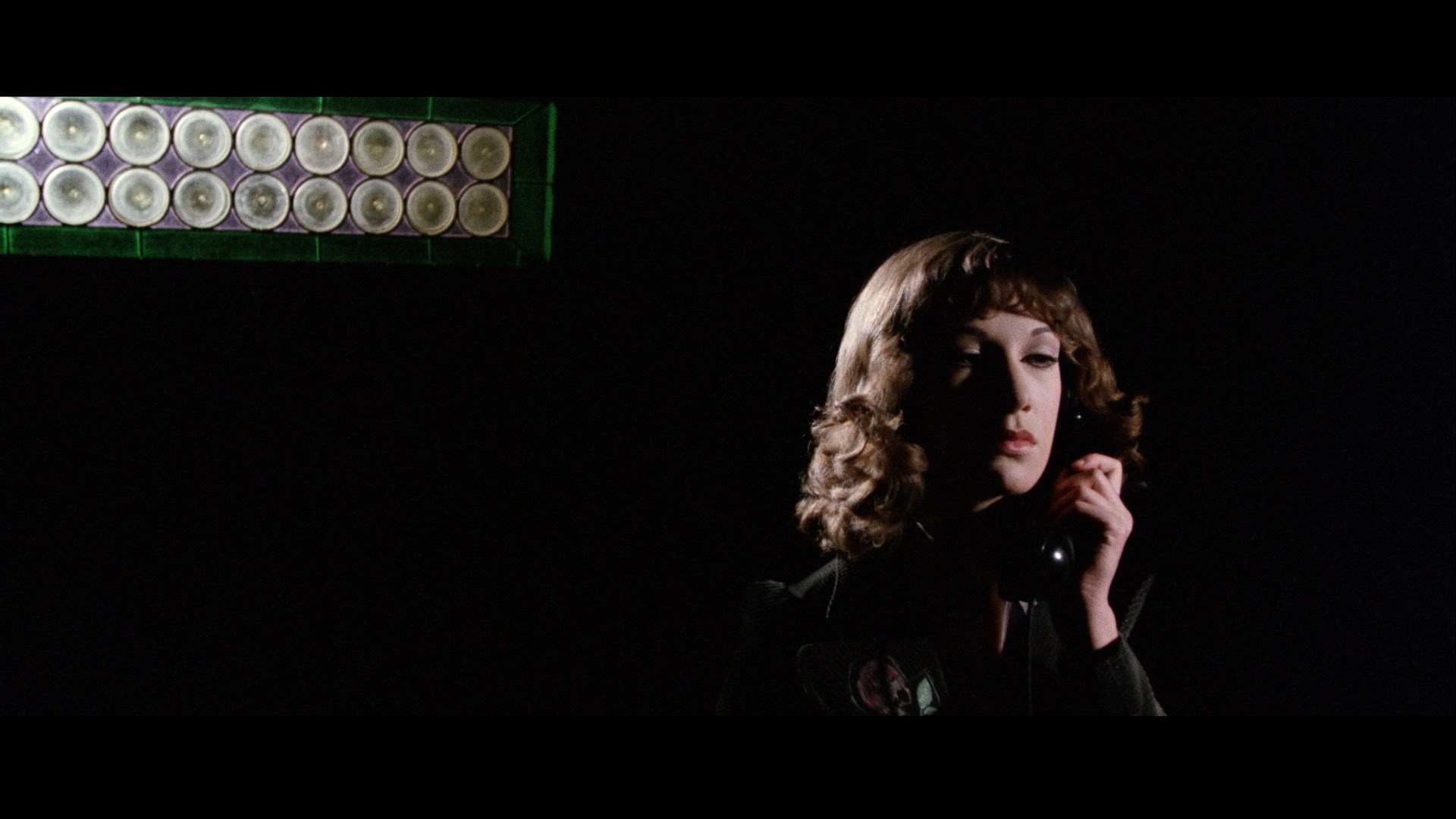 closing credits were prepared both in Italian and English ("You have been watching Deep Red!"), the DVD controversially included a newly created variant with the English credits rolling over a still shot of Hemmings' face. It's a bizarre alteration that immediately irritated purists and remained a sticking point for years. As for audio, the mono soundtrack was been remixed to 5.1, with decent results. The music carries most of the load for the exterior sequences, with only a few sound effects making their way to the rear channels. A few sequences which would seem to call out for the 5.1 treatment, such as the gruesome garbage truck scene, remain almost entirely dead center. The Italian dialogue is presented with subtitles during the additional scenes for the English soundtrack, while the Italian-only version may be played with subtitles throughout. The disc includes two theatrical trailers: one for the U.S. (a longer version of the one included on Mad Ron's Prevues from Hell) and the original Italian (which includes some intriguing still photos). Argento appears for an intriguing interview segment in which he's joined by Goblin band members and co-writer Bernardino Zapponi. However, the biggest drawback to the Anchor Bay version is the liner notes, among the most inept ever published. The subsequent reissue from Blue Underground ports over the exact same transfer and contents but thankfully without the insert.
closing credits were prepared both in Italian and English ("You have been watching Deep Red!"), the DVD controversially included a newly created variant with the English credits rolling over a still shot of Hemmings' face. It's a bizarre alteration that immediately irritated purists and remained a sticking point for years. As for audio, the mono soundtrack was been remixed to 5.1, with decent results. The music carries most of the load for the exterior sequences, with only a few sound effects making their way to the rear channels. A few sequences which would seem to call out for the 5.1 treatment, such as the gruesome garbage truck scene, remain almost entirely dead center. The Italian dialogue is presented with subtitles during the additional scenes for the English soundtrack, while the Italian-only version may be played with subtitles throughout. The disc includes two theatrical trailers: one for the U.S. (a longer version of the one included on Mad Ron's Prevues from Hell) and the original Italian (which includes some intriguing still photos). Argento appears for an intriguing interview segment in which he's joined by Goblin band members and co-writer Bernardino Zapponi. However, the biggest drawback to the Anchor Bay version is the liner notes, among the most inept ever published. The subsequent reissue from Blue Underground ports over the exact same transfer and contents but thankfully without the insert.
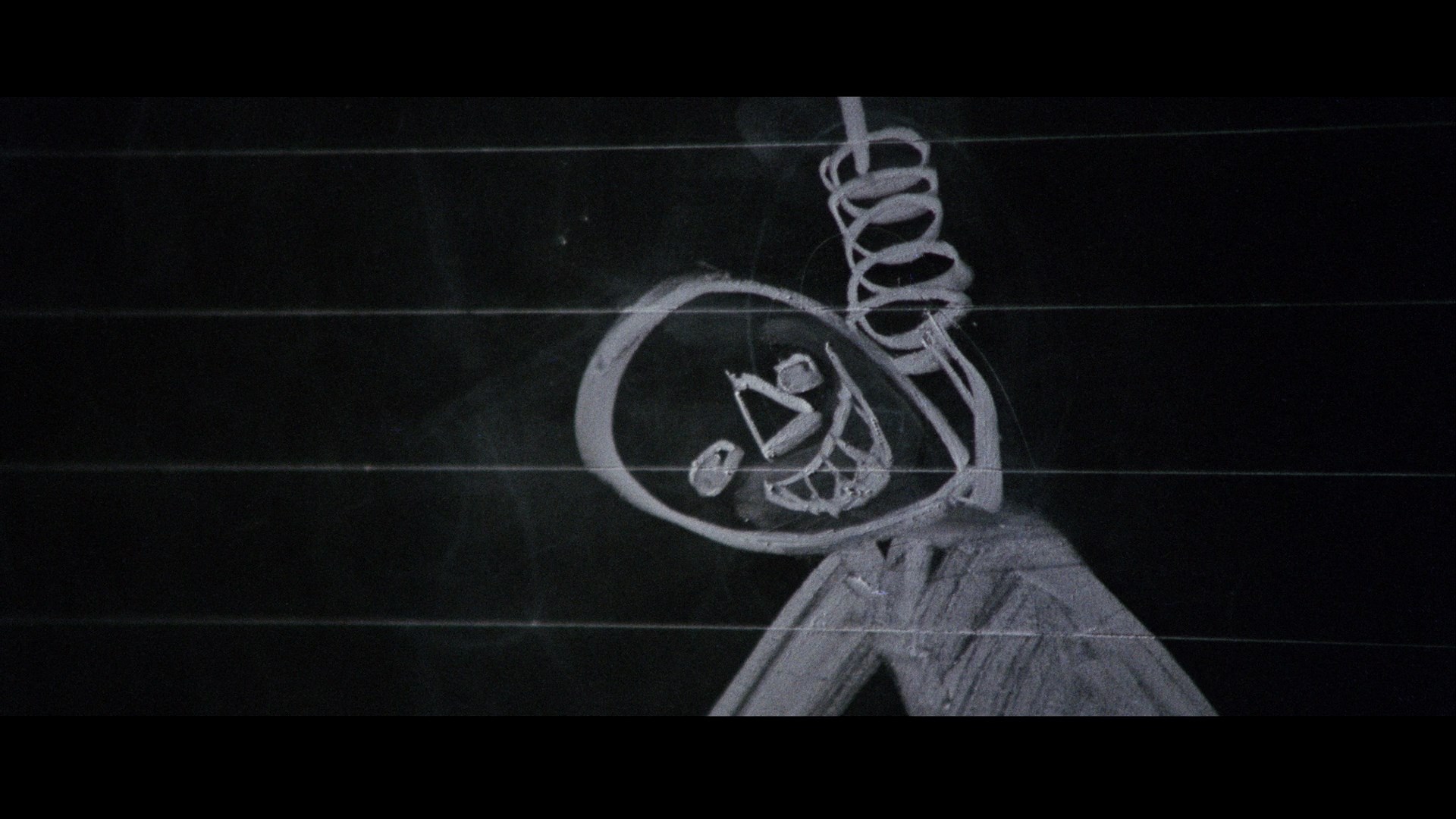 better way to experience the film for first-time viewers who can then move to the
better way to experience the film for first-time viewers who can then move to the  Italian version once their feet are wet) first got their prayers answered with AWE's very welcome two-disc release, which ditches the US featurette but is in every other way an improvement. Disc one contains the long Italian cut with English, Dutch, and Finnish subtitles, with audio in 5.1 or 2.0 stereo. Viewers watching it in progressive mode will notice some jerky motion problems from time to time (unfortunately most obvious during those great close-up gliding shots through the killer's dolls and other artifacts) due to the original master being created in NTSC. The first disc also contains the same two trailers as well as a great new bonus, a full commentary track by the disc's producer, Thomas Rostock, who provides one of the most engaging breakdowns of an Argento film ever created. He's extremely knowledgeable about the film and rattles off both reams of amazing trivia and eye-opening insights into the themes, structure and symbolism of the film; you'll never watch it the same way again. Interestingly, he delves into some of the Hebrew imagery present in the first half and the continental tensions running throughout the story; for an interesting companion piece, check out the thematically similar Phenomena, which takes place during Passover and has some truly grotesque religious undercurrents. Disco two contains the 105-minute cut for the first time in full scope; the bulk of it appears to be of the same transfer quality as the Italian cut (from which it was most likely created), but the closing titles are obviously taken from a different and slightly more worn print. The second disc is rounded out with the Dario Argento: An Eye for Horror UK TV special, which everyone probably has already. You also get new trivia-packed bios for Argento, Hemmings and Nicolodi, a still gallery, and a liner notes booklet in Danish.
Italian version once their feet are wet) first got their prayers answered with AWE's very welcome two-disc release, which ditches the US featurette but is in every other way an improvement. Disc one contains the long Italian cut with English, Dutch, and Finnish subtitles, with audio in 5.1 or 2.0 stereo. Viewers watching it in progressive mode will notice some jerky motion problems from time to time (unfortunately most obvious during those great close-up gliding shots through the killer's dolls and other artifacts) due to the original master being created in NTSC. The first disc also contains the same two trailers as well as a great new bonus, a full commentary track by the disc's producer, Thomas Rostock, who provides one of the most engaging breakdowns of an Argento film ever created. He's extremely knowledgeable about the film and rattles off both reams of amazing trivia and eye-opening insights into the themes, structure and symbolism of the film; you'll never watch it the same way again. Interestingly, he delves into some of the Hebrew imagery present in the first half and the continental tensions running throughout the story; for an interesting companion piece, check out the thematically similar Phenomena, which takes place during Passover and has some truly grotesque religious undercurrents. Disco two contains the 105-minute cut for the first time in full scope; the bulk of it appears to be of the same transfer quality as the Italian cut (from which it was most likely created), but the closing titles are obviously taken from a different and slightly more worn print. The second disc is rounded out with the Dario Argento: An Eye for Horror UK TV special, which everyone probably has already. You also get new trivia-packed bios for Argento, Hemmings and Nicolodi, a still gallery, and a liner notes booklet in Danish.
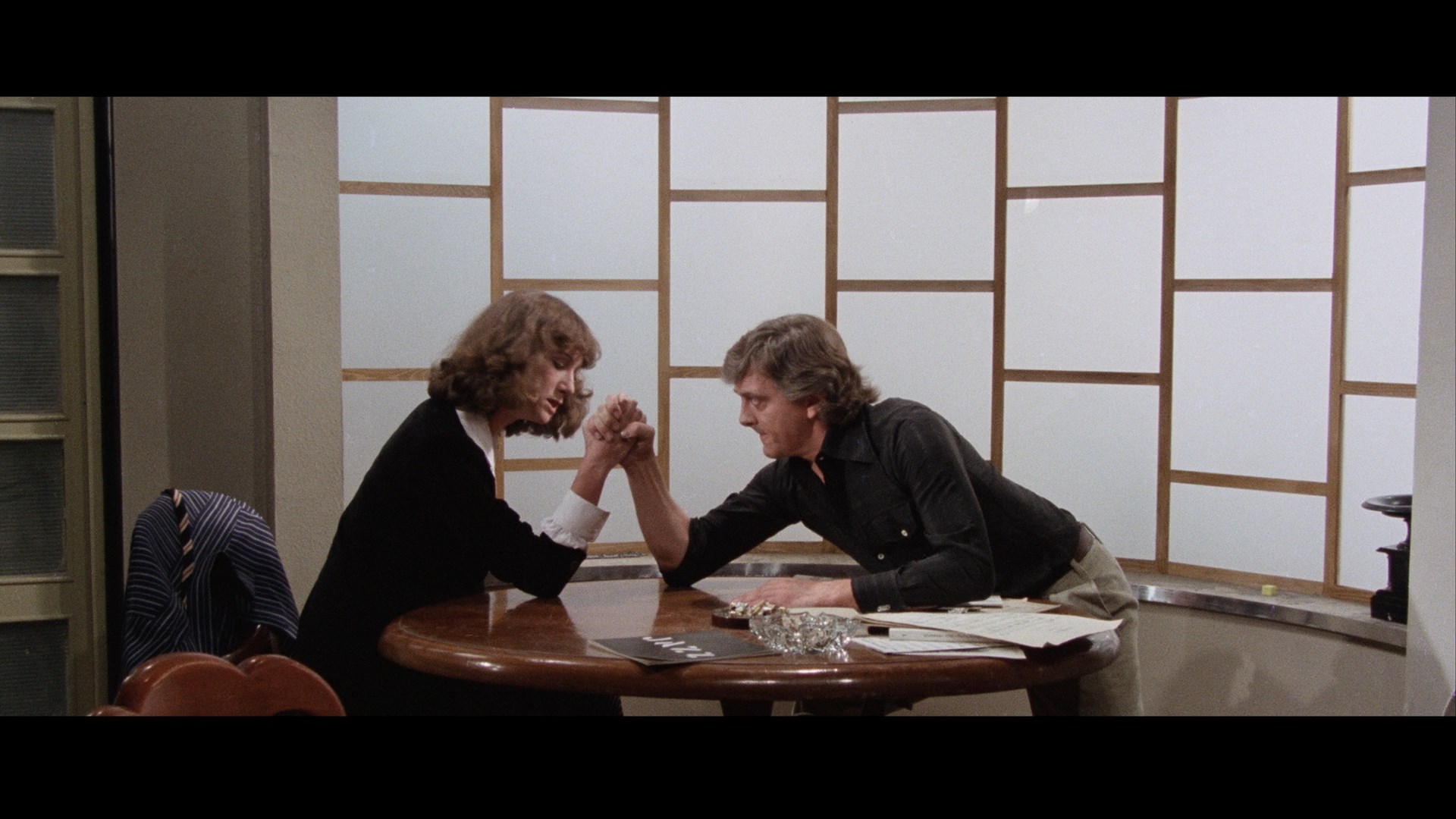 one of the strangest developments in this title's already bizarre video history, the Blu-ray era brought in two releases almost simultaneously in the UK and US in 2011. First out of the gate is the
one of the strangest developments in this title's already bizarre video history, the Blu-ray era brought in two releases almost simultaneously in the UK and US in 2011. First out of the gate is the 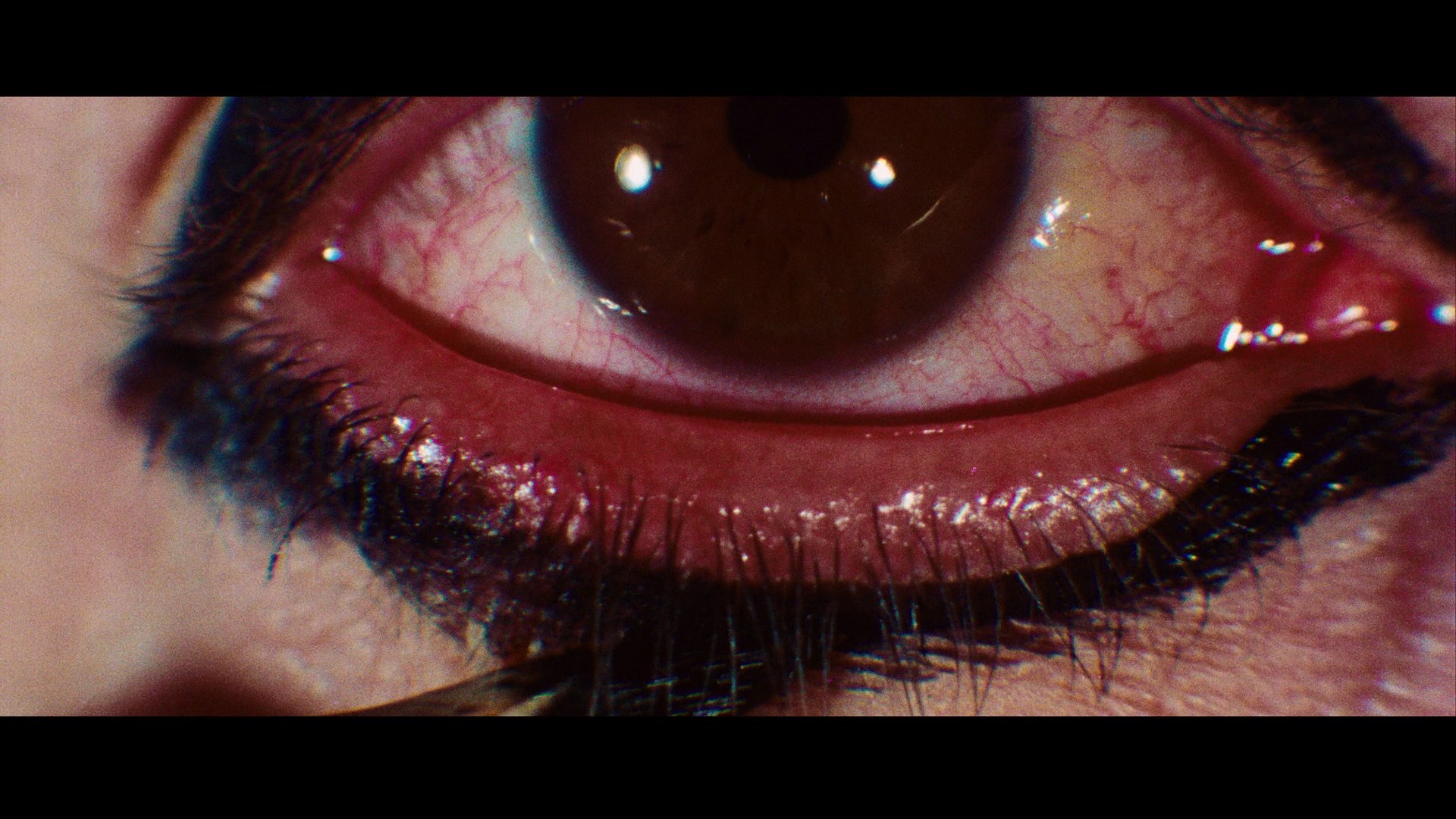 British Arrow release, a two-disc set that contains the complete Italian cut on the first disc and the 105-minute, all-English cut on disc two. This version was culled from an Italian HD master originally premiered as a digital release and looks better than any of the DVD versions, though flesh tones in some scenes have an odd yellow cast that makes some of the actors look jaundiced. Some obvious grain removal in a few key scenes also softens the image more than necessary, particularly in close-up shots. (There's also an odd, distracting, and major digital glitch at the 45:30 mark over Gabriele Lavia's face.) For the English version, the opening and closing titles in English have obviously been spliced in from a much lower quality standard def source. It's not bad and definitely beats any standard def option by a long shot (especially for the price), but the room for improvement is obvious. The 5.1 remix is also effective but occasionally problematic, including some awkward shifts to multi-channel music tracks that sound like they were abruptly looped in from a CD (especially the doll-and-eyeliner montage with the main theme playing after the close-up of the bathroom sink). The language options on the Italian track are essentially the same as the American DVDs, either all Italian with optional subtitles or that jarring mixture of English and subtitled Italian which often jumps back and forth within the same scene. What will make this one a must for Argento fans is the raft of extras including a video intro by Simonetti (24s), the terrific Rostock commentary from the AWE disc, the Italian and English trailers, a new "The Lady in Red" (18m45s) video interview with Nicolodi (shot back-to-back with her interview for Arrow's Inferno) in which she talks about meeting Argento and doing her first project with him, an English-language "Music to Murder For!" interview with Simonetti
British Arrow release, a two-disc set that contains the complete Italian cut on the first disc and the 105-minute, all-English cut on disc two. This version was culled from an Italian HD master originally premiered as a digital release and looks better than any of the DVD versions, though flesh tones in some scenes have an odd yellow cast that makes some of the actors look jaundiced. Some obvious grain removal in a few key scenes also softens the image more than necessary, particularly in close-up shots. (There's also an odd, distracting, and major digital glitch at the 45:30 mark over Gabriele Lavia's face.) For the English version, the opening and closing titles in English have obviously been spliced in from a much lower quality standard def source. It's not bad and definitely beats any standard def option by a long shot (especially for the price), but the room for improvement is obvious. The 5.1 remix is also effective but occasionally problematic, including some awkward shifts to multi-channel music tracks that sound like they were abruptly looped in from a CD (especially the doll-and-eyeliner montage with the main theme playing after the close-up of the bathroom sink). The language options on the Italian track are essentially the same as the American DVDs, either all Italian with optional subtitles or that jarring mixture of English and subtitled Italian which often jumps back and forth within the same scene. What will make this one a must for Argento fans is the raft of extras including a video intro by Simonetti (24s), the terrific Rostock commentary from the AWE disc, the Italian and English trailers, a new "The Lady in Red" (18m45s) video interview with Nicolodi (shot back-to-back with her interview for Arrow's Inferno) in which she talks about meeting Argento and doing her first project with him, an English-language "Music to Murder For!" interview with Simonetti 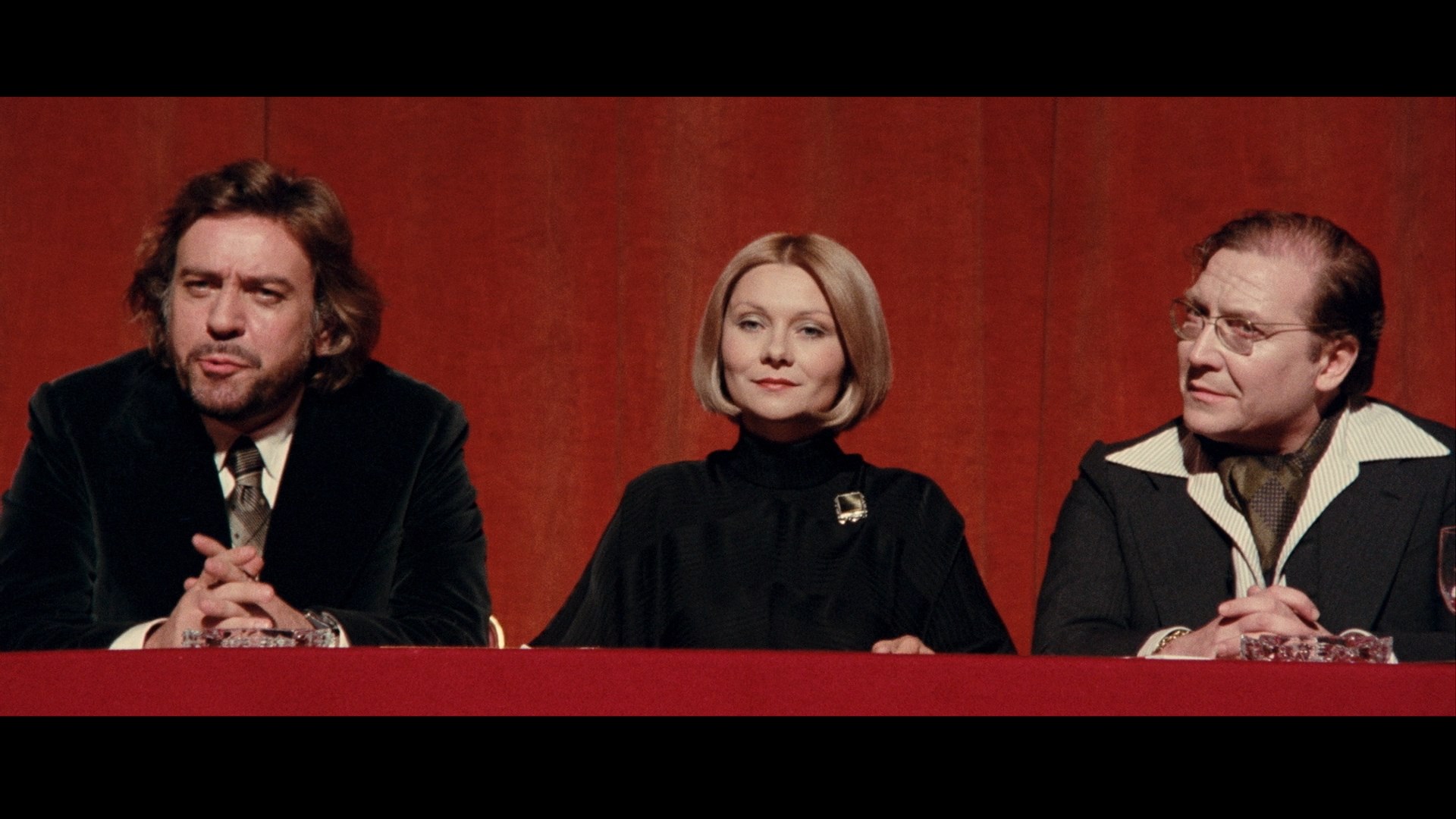 (14m5s) about the formation of Goblin and how they were brought on to adapt with Gaslini's score, and a "Rosso Recollections" (12m24s) interview with Argento about the genesis of his early thrillers and the process that led to Deep Red including some oblique nods to Agatha Christie. The
(14m5s) about the formation of Goblin and how they were brought on to adapt with Gaslini's score, and a "Rosso Recollections" (12m24s) interview with Argento about the genesis of his early thrillers and the process that led to Deep Red including some oblique nods to Agatha Christie. The 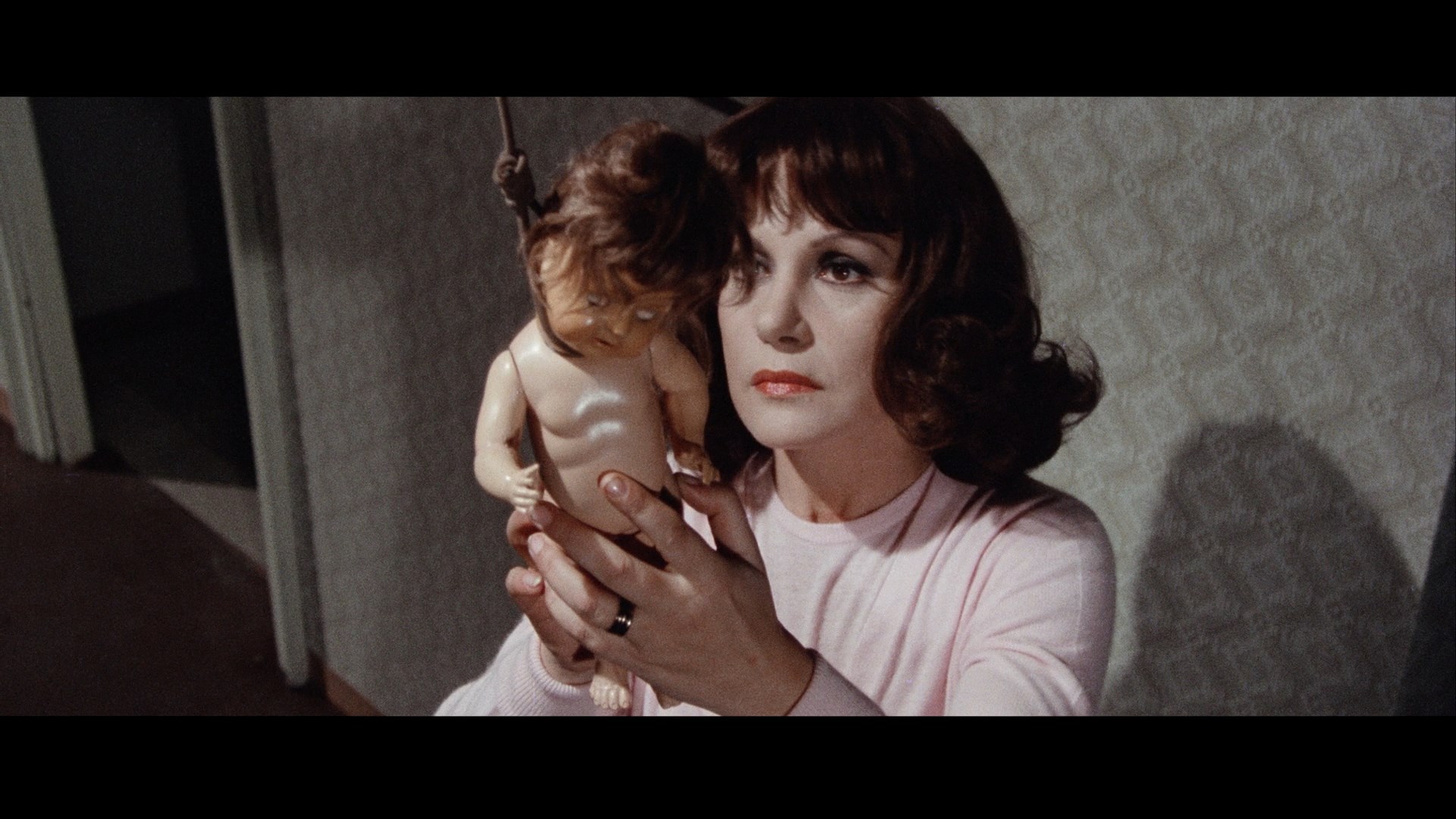 second disc also adds a fun look at the Argento-founded Profondo Rosso shop in Rome run by Luigi Cozzi called "Rosso from Celluloid to Shop" (14m28s), while the typically lavish packaging includes reversible artwork with four cover options, a fold-out poster, and a booklet with solid liner notes by Alan Jones.
second disc also adds a fun look at the Argento-founded Profondo Rosso shop in Rome run by Luigi Cozzi called "Rosso from Celluloid to Shop" (14m28s), while the typically lavish packaging includes reversible artwork with four cover options, a fold-out poster, and a booklet with solid liner notes by Alan Jones.
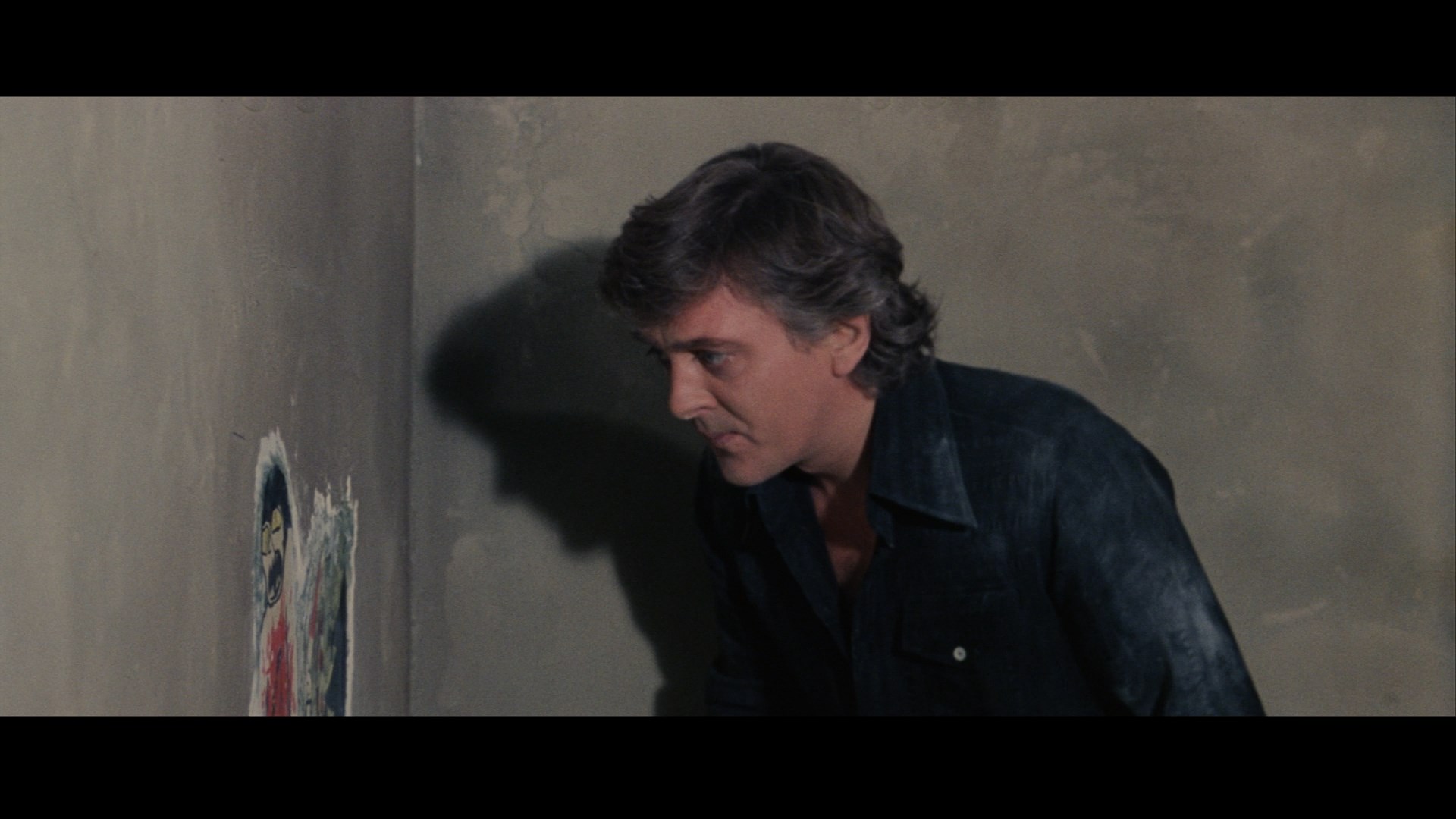 include French and Spanish. The same subtitle options (though English is SDH this time) are included for the 105-minute cut, making its American home video debut. The transfer itself is equal to the Italian one but also sports much better-looking opening and closing English credits.
include French and Spanish. The same subtitle options (though English is SDH this time) are included for the 105-minute cut, making its American home video debut. The transfer itself is equal to the Italian one but also sports much better-looking opening and closing English credits. 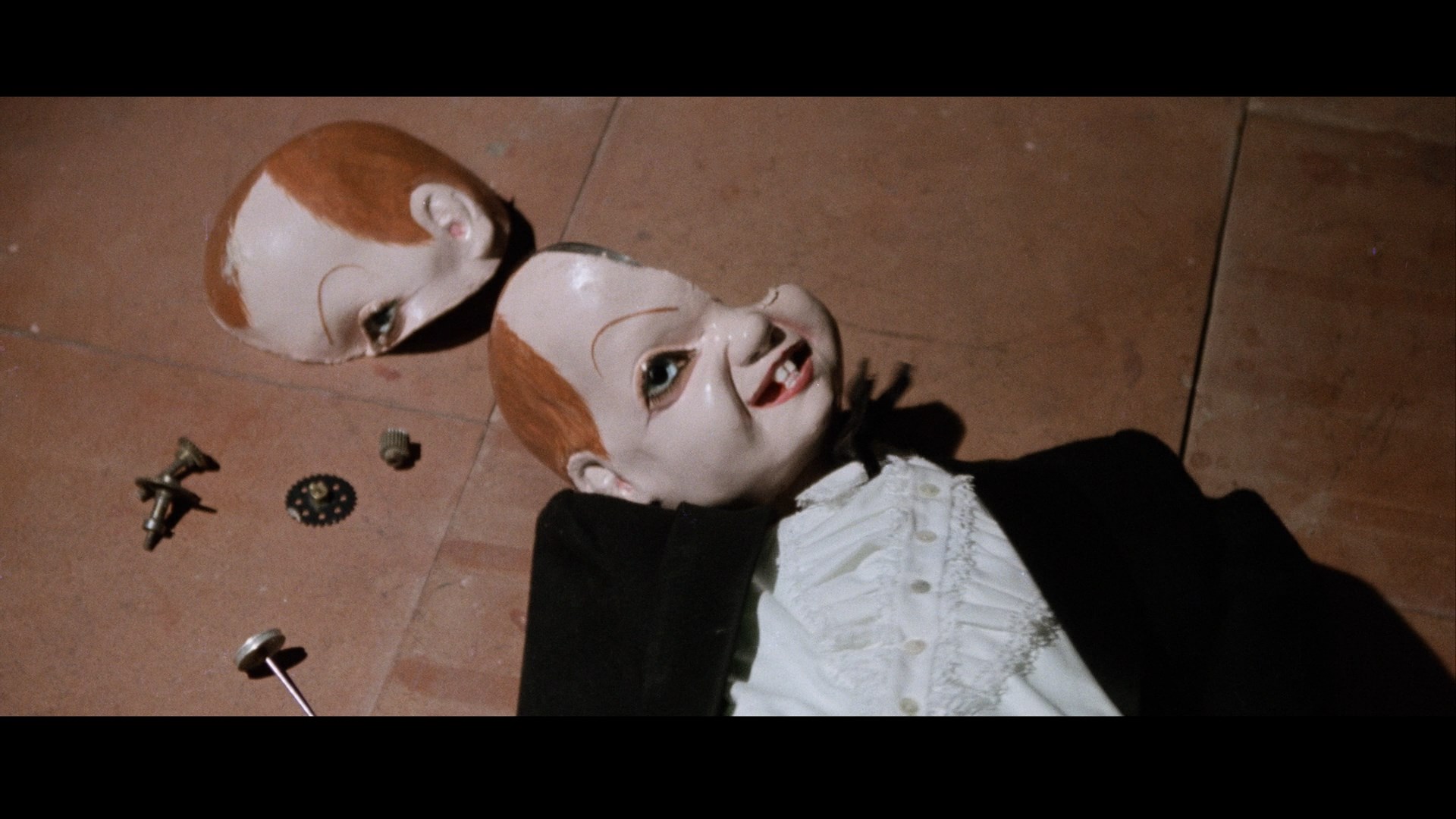 For the record, the end titles on both versions are the original theatrical ones with Hemmings continuing to move; no digital monkeying around this time. In a strange quirk with this particular master, the heads and tails of some shots have a few frames of obviously unintended extraneous footage that causes some jump cuts, most obviously the forensics investigation shots in Helga's apartment after her murder. Extras are ported over from the Blue Underground DVD including the Argento/Goblin/Zapponi featurette, the Italian and English trailers, and the Daemonia music video by Sergio Stivaletti. Special mention should also go to the striking menus, which make clever use of the Italian Vertigo-inspired poster art.
For the record, the end titles on both versions are the original theatrical ones with Hemmings continuing to move; no digital monkeying around this time. In a strange quirk with this particular master, the heads and tails of some shots have a few frames of obviously unintended extraneous footage that causes some jump cuts, most obviously the forensics investigation shots in Helga's apartment after her murder. Extras are ported over from the Blue Underground DVD including the Argento/Goblin/Zapponi featurette, the Italian and English trailers, and the Daemonia music video by Sergio Stivaletti. Special mention should also go to the striking menus, which make clever use of the Italian Vertigo-inspired poster art.
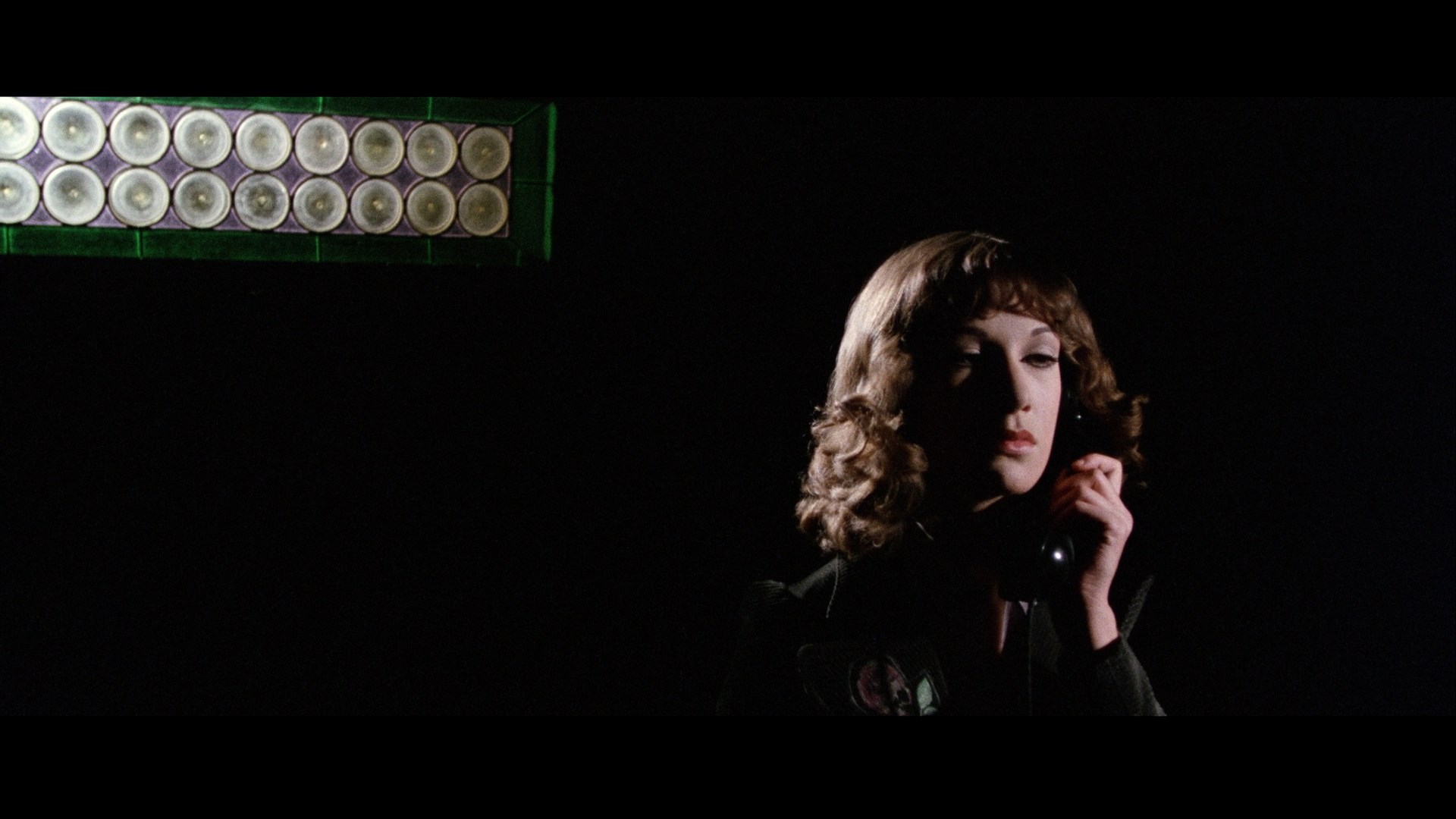 dimensional than before. (That transfer is the source of all the frame grabs seen throughout the body of this review.) There's also a significant amount of additional image information visible on the left and bottom of the frame, which actually helps out the compositions in several shots. Due to a new opening text intro explaining the restoration process, the running time is now slightly
dimensional than before. (That transfer is the source of all the frame grabs seen throughout the body of this review.) There's also a significant amount of additional image information visible on the left and bottom of the frame, which actually helps out the compositions in several shots. Due to a new opening text intro explaining the restoration process, the running time is now slightly 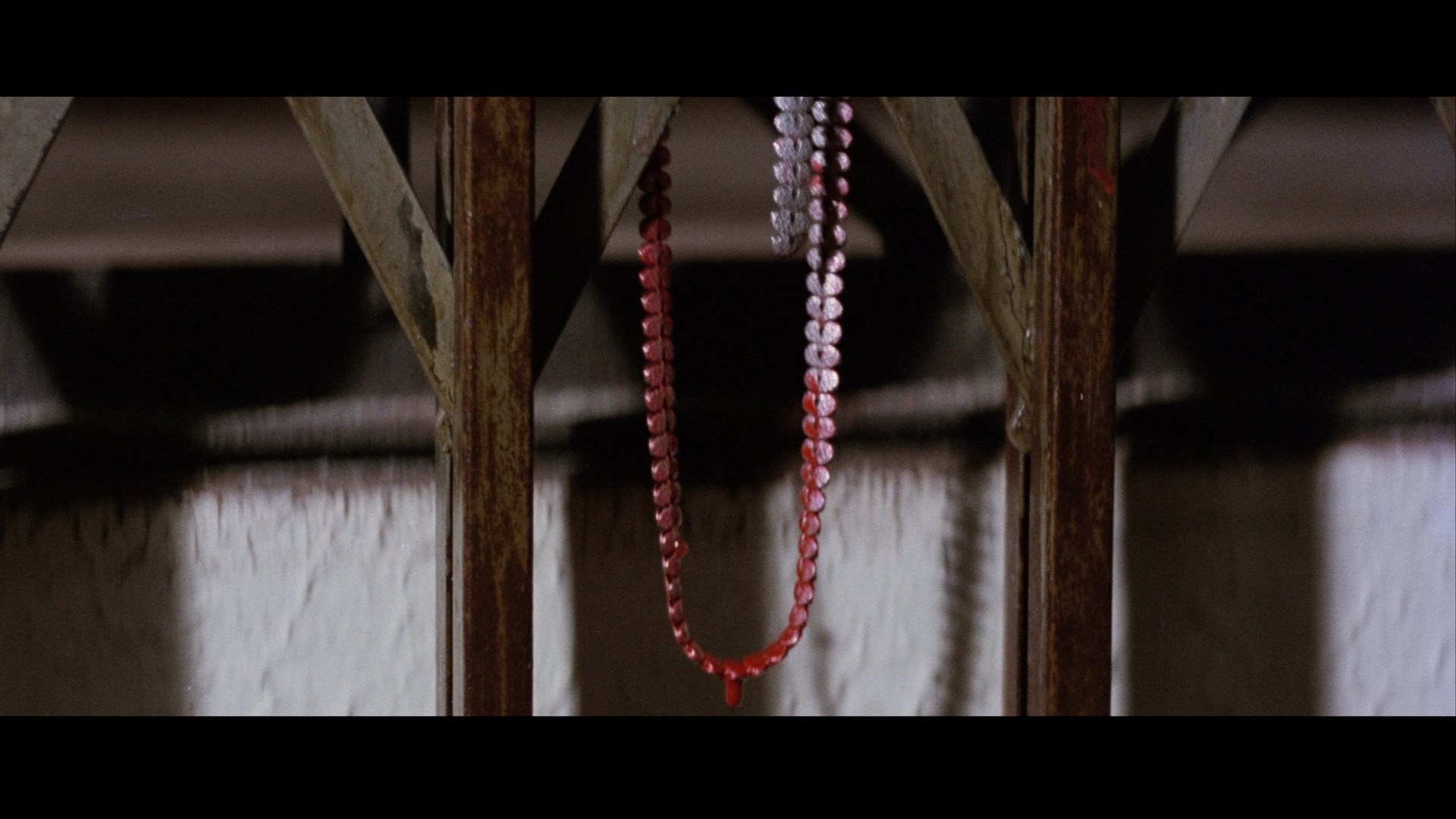 longer thank usual and clocks in at 127 minutes and 14 seconds. Exclusive to this set is a second disc containing the 105-minute theatrical cut, sourced from the same greatly improved restored source with English LPCM mono audio with optional English subtitles. The familiar U.S. trailer is also included as an extra in HD, and the third disc is a 28-track CD soundtrack containing the full Goblin and Gaslini score (albeit without the extra demos found on the double-disc Cinevox set linked above). The generous packaging includes six postcard-sized lobby card reproductions, a double-sided fold-out poster, the usual reversible sleeve art options, and a liner notes booklet with a new essay by Mikel J. Koven (La Dolce Morte: Vernacular Cinema and the Italian Giallo Film) and the older essay by Alan Jones. The same essential package was issued belatedly in the U.S. in 2018, featuring both Blu-rays but minus the soundtrack CD.
longer thank usual and clocks in at 127 minutes and 14 seconds. Exclusive to this set is a second disc containing the 105-minute theatrical cut, sourced from the same greatly improved restored source with English LPCM mono audio with optional English subtitles. The familiar U.S. trailer is also included as an extra in HD, and the third disc is a 28-track CD soundtrack containing the full Goblin and Gaslini score (albeit without the extra demos found on the double-disc Cinevox set linked above). The generous packaging includes six postcard-sized lobby card reproductions, a double-sided fold-out poster, the usual reversible sleeve art options, and a liner notes booklet with a new essay by Mikel J. Koven (La Dolce Morte: Vernacular Cinema and the Italian Giallo Film) and the older essay by Alan Jones. The same essential package was issued belatedly in the U.S. in 2018, featuring both Blu-rays but minus the soundtrack CD.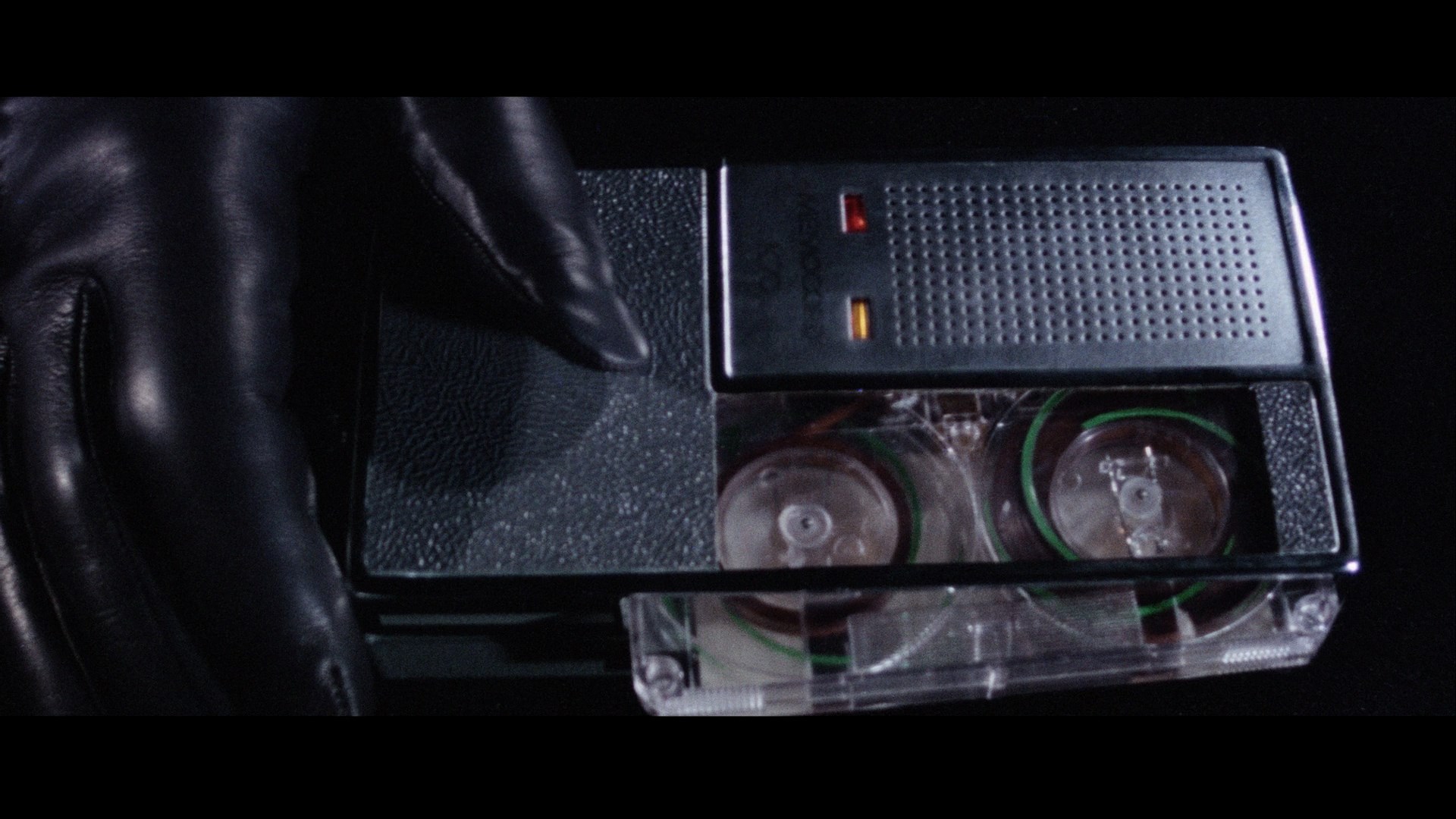 with Argento
with Argento 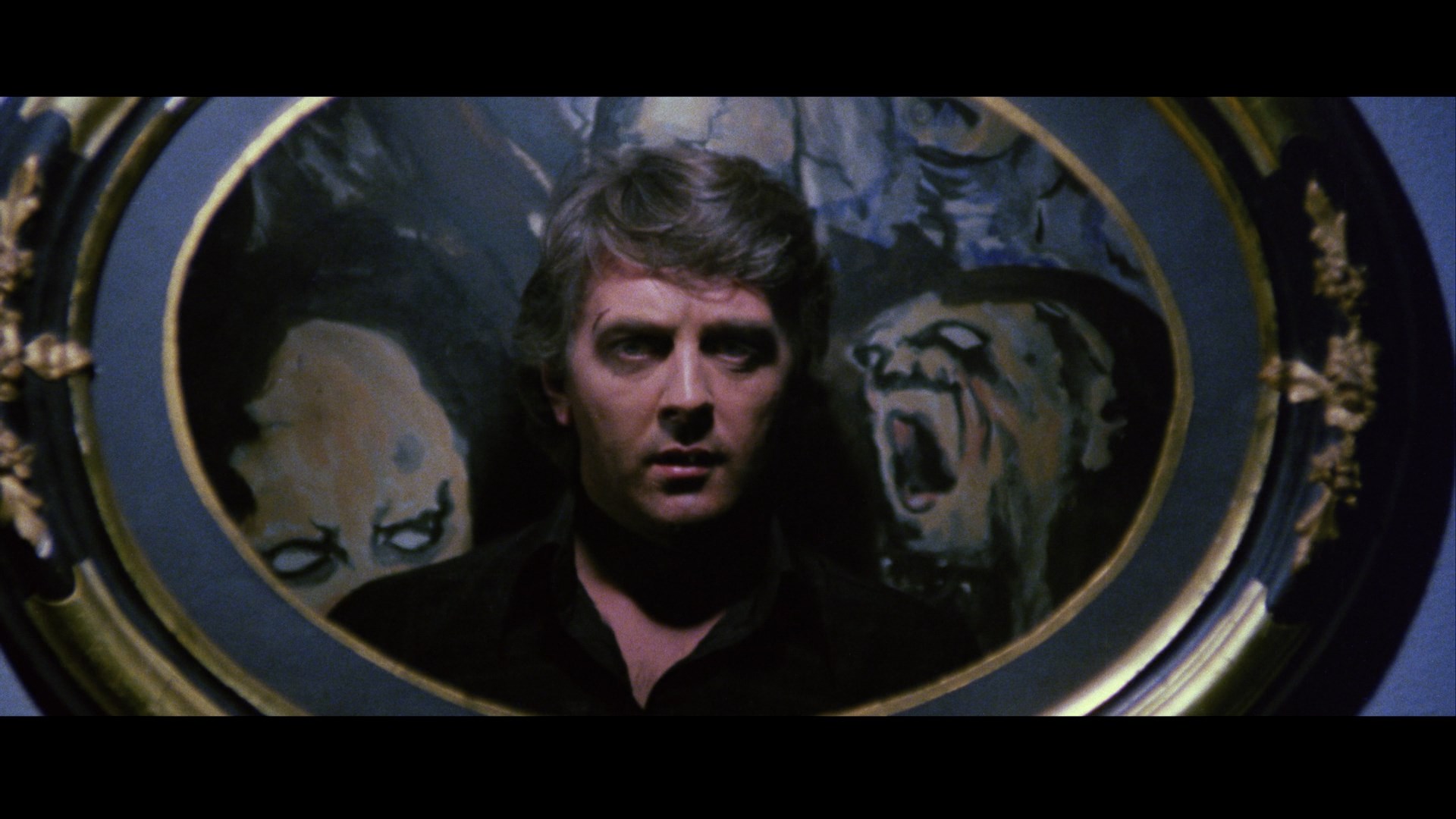 including this film, as well as their professional interactions in the industry in general over the years including the director's producer father, Salvatore. Claudio Simonetti pops up again in "Death Dies" (14m47s) for an additional look at his musical piano-focused background and his early days with Goblin, while "Carlo Never Dies" (15m32s) with Lavia recounts his career at the time balancing theater and film work including a TV drama he was doing just before this, with him and his director enjoying such a good rapport they teamed up again on two more films. A particularly fun new angle can be found in "I Am the Screaming Child" (7m43s) with actor Jacopo Mariani, whose small but pivotal role as a child (wouldn't dream of spoiling who) made great use of his expressive eyes (which still look the same!). Of course, he also talks about the next role he played for Argento as the spooky kid Albert in Suspiria, too, which marked the end of his acting career. In "Bloodstained" (5m28s), actor Lino Capolicchio briefly chats about being the original choice for the role of Marcus (having been associated with Argento on Metti, una sera a cena), something he compensated for by appearing in some other key gialli like The House with Laughing Windows and The Bloodstained Shadow. Also on the first disc are the Italian trailer and a 2018 Arrow Video trailer, followed by five separate galleries for posters, lobby cards, promotional stills, the Japanese pressbook and flyer, and soundtrack releases. The feature itself ports over the Rostock commentary while also adding a new one by Troy Howarth and this writer, which obviously can't be assessed here but will hopefully prove enjoyable.
including this film, as well as their professional interactions in the industry in general over the years including the director's producer father, Salvatore. Claudio Simonetti pops up again in "Death Dies" (14m47s) for an additional look at his musical piano-focused background and his early days with Goblin, while "Carlo Never Dies" (15m32s) with Lavia recounts his career at the time balancing theater and film work including a TV drama he was doing just before this, with him and his director enjoying such a good rapport they teamed up again on two more films. A particularly fun new angle can be found in "I Am the Screaming Child" (7m43s) with actor Jacopo Mariani, whose small but pivotal role as a child (wouldn't dream of spoiling who) made great use of his expressive eyes (which still look the same!). Of course, he also talks about the next role he played for Argento as the spooky kid Albert in Suspiria, too, which marked the end of his acting career. In "Bloodstained" (5m28s), actor Lino Capolicchio briefly chats about being the original choice for the role of Marcus (having been associated with Argento on Metti, una sera a cena), something he compensated for by appearing in some other key gialli like The House with Laughing Windows and The Bloodstained Shadow. Also on the first disc are the Italian trailer and a 2018 Arrow Video trailer, followed by five separate galleries for posters, lobby cards, promotional stills, the Japanese pressbook and flyer, and soundtrack releases. The feature itself ports over the Rostock commentary while also adding a new one by Troy Howarth and this writer, which obviously can't be assessed here but will hopefully prove enjoyable.

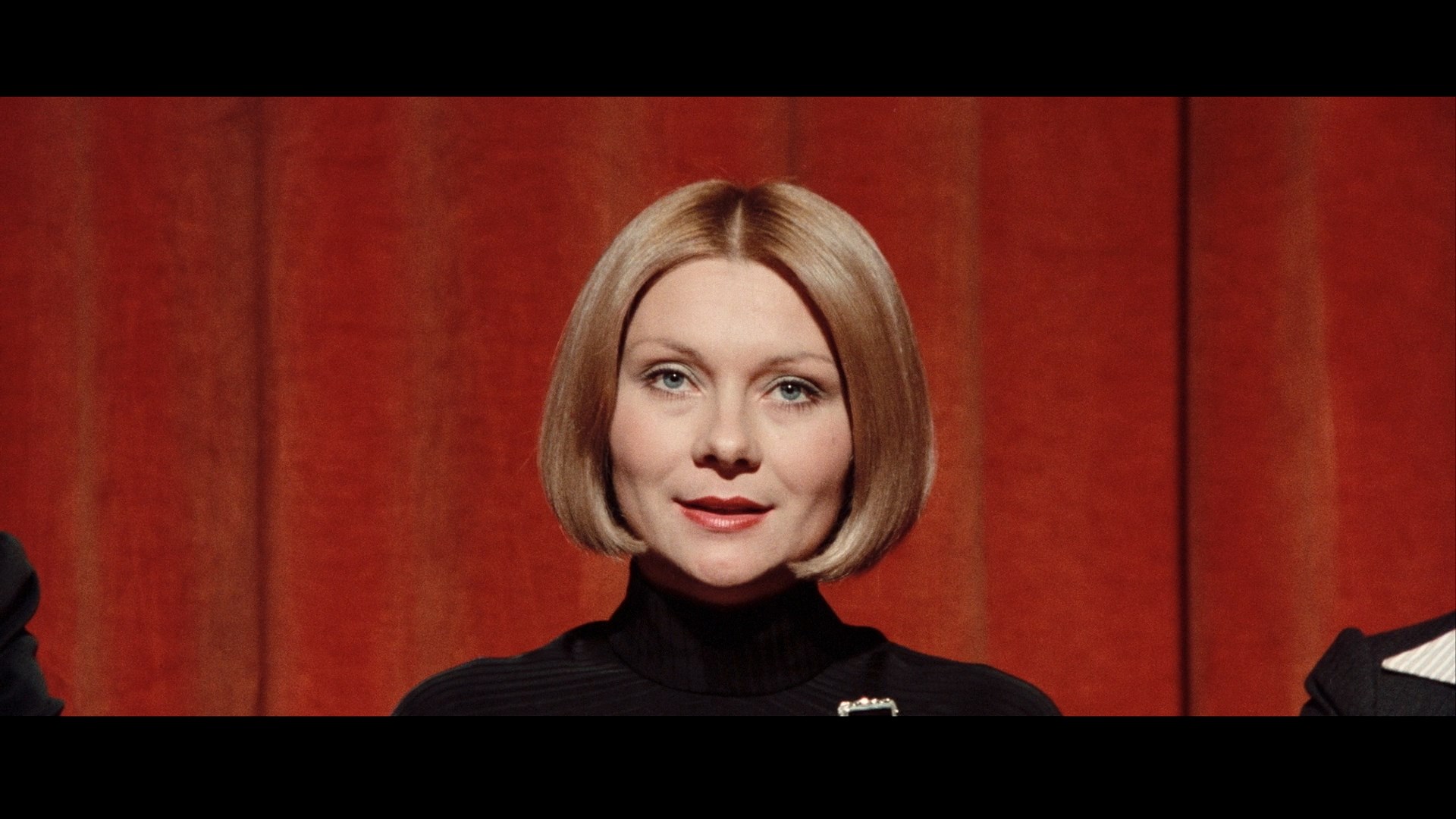
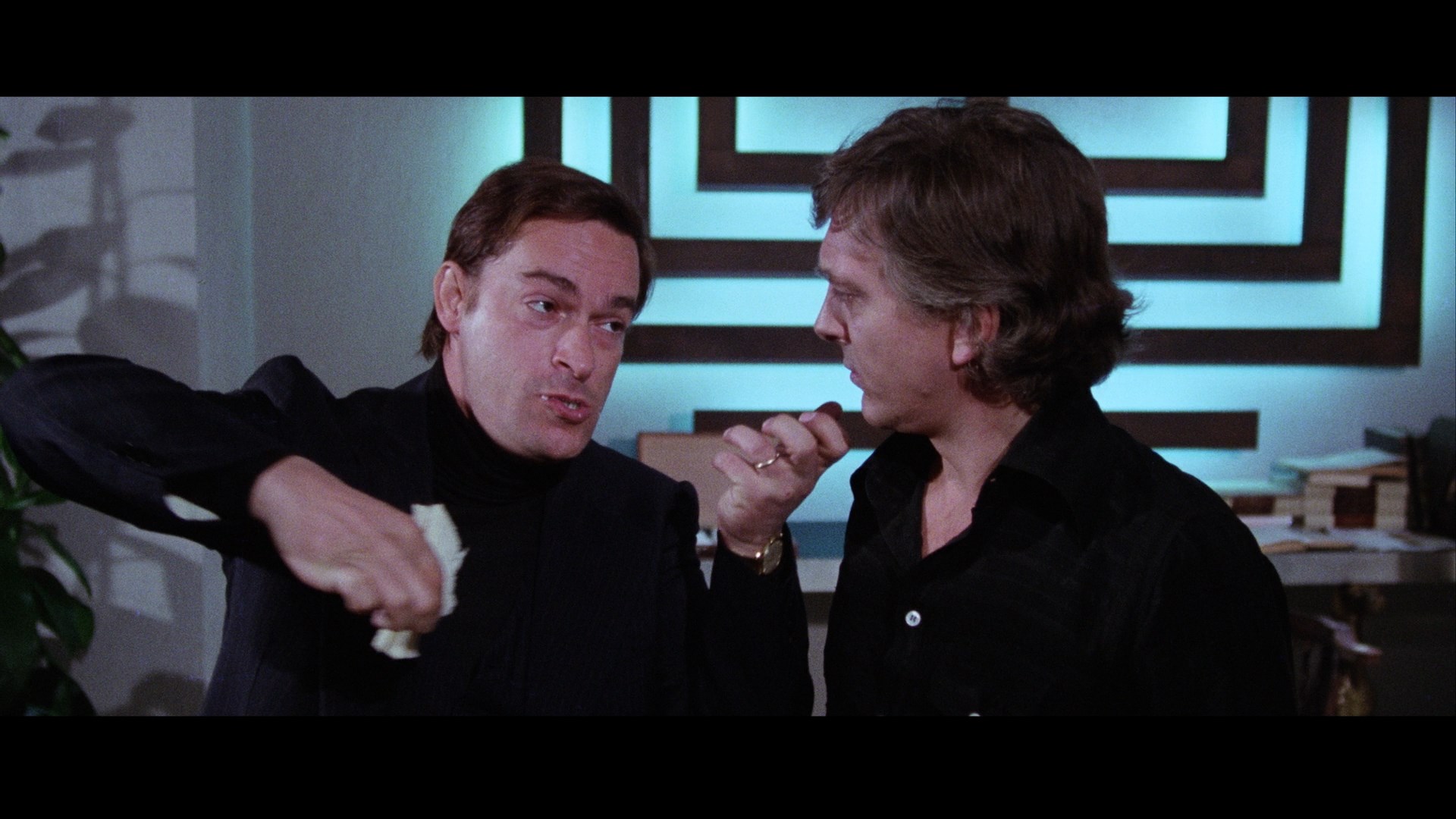

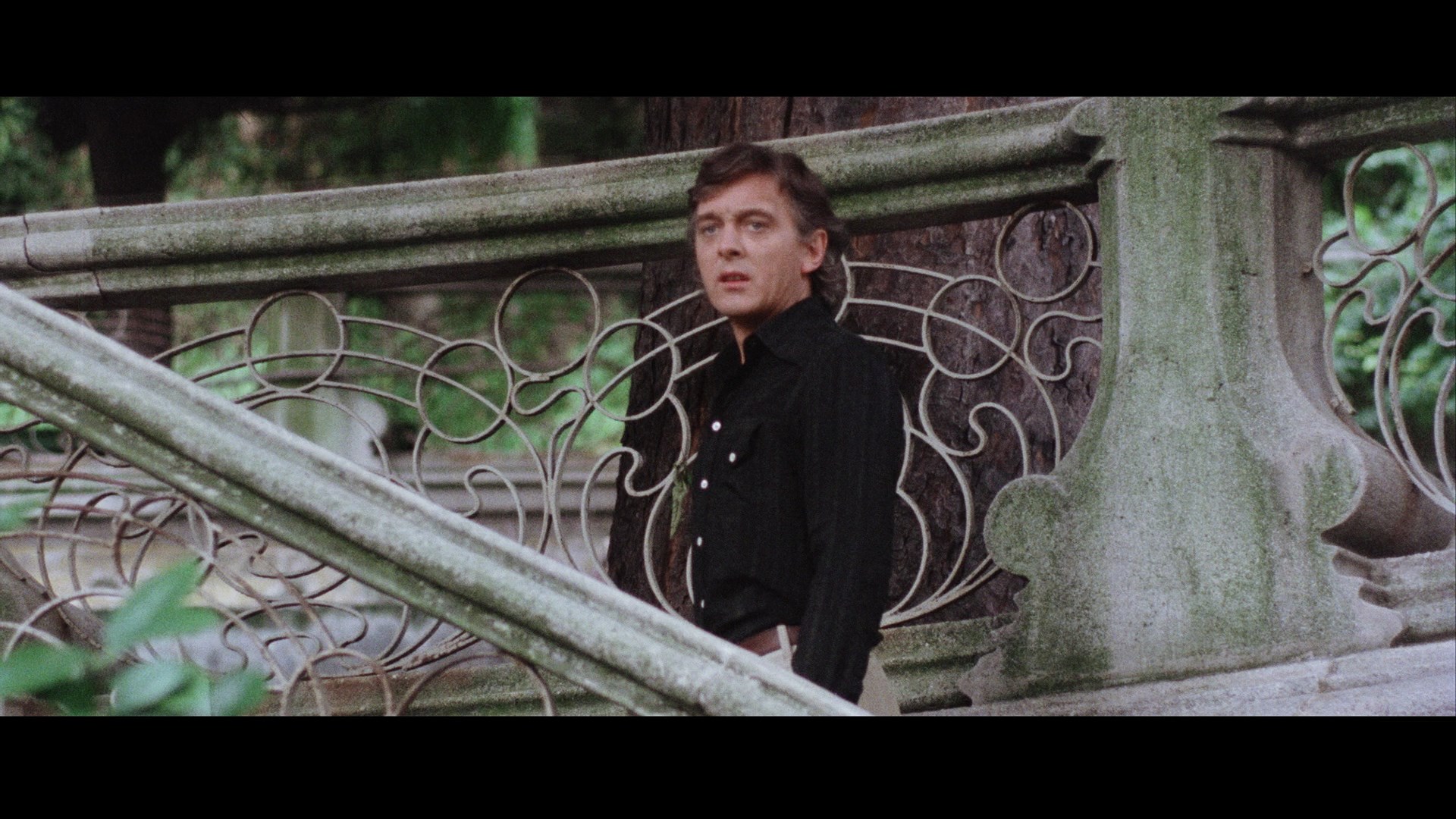
![]()